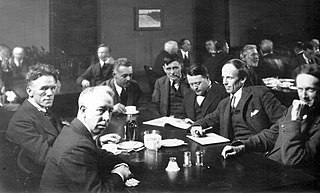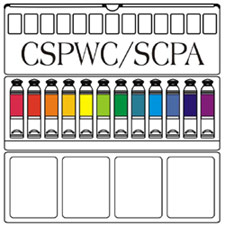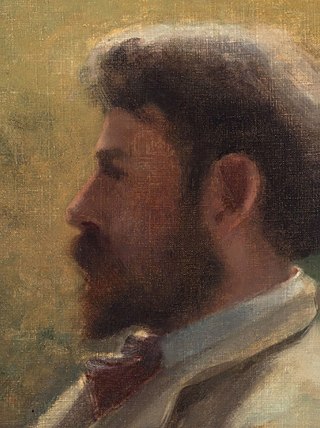
The Group of Seven, once known as the Algonquin School, was a group of Canadian landscape painters from 1920 to 1933, with "a like vision". It originally consisted of Franklin Carmichael (1890–1945), Lawren Harris (1885–1970), A. Y. Jackson (1882–1974), Frank Johnston (1888–1949), Arthur Lismer (1885–1969), J. E. H. MacDonald (1873–1932), and Frederick Varley (1881–1969). A. J. Casson (1898–1992) was invited to join in 1926, Edwin Holgate (1892–1977) became a member in 1930, and Lionel LeMoine FitzGerald (1890–1956) joined in 1932.

Arthur Lismer, LL.D. was an English-Canadian painter, member of the Group of Seven and educator. He is known primarily as a landscape painter and for his paintings of ships in dazzle camouflage.

Franklin Carmichael was a Canadian artist and member of the Group of Seven. Though he was primarily famous for his use of watercolours, he also used oil paints, charcoal and other media to capture the Ontario landscapes. Besides his work as a painter, he worked as a designer and illustrator, creating promotional brochures, advertisements in newspapers and magazines, and designing books. Near the end of his life, Carmichael taught in the Graphic Design and Commercial Art Department at the Ontario College of Art.

Alfred Joseph Casson was a member of the Canadian group of artists known as the Group of Seven. He joined the group in 1926 at the invitation of Franklin Carmichael, replacing Frank Johnston. Casson is best known for his depictions in his signature limited palette of southern Ontario, and for being the youngest member of the Group of Seven.

Charles Fraser Comfort, LL. D. was a Scottish-born Canadian painter, sculptor, teacher, writer and administrator.
Jack Leonard Shadbolt, was a Canadian painter.

The Canadian Society of Painters in Water Colour, founded in 1925, is considered to be Canada's official national watercolour Society. Since the 1980s the Society has enjoyed Vice-regal Patronage from the incumbent Governor General of Canada. Recognized by a long list of international exhibitions it is the Canadian equivalent of such other national societies as the American Watercolor Society of the United States, the Royal Watercolour Society of the United Kingdom, etc.

Painters Eleven was a group of abstract artists active in Canada between 1953 and 1960. They are associated with the Abstract Expressionist movement.

Jack Hamilton Bush was a Canadian abstract painter. A member of Painters Eleven, his paintings are associated with the Color Field movement and Post-painterly Abstraction. Inspired by Henri Matisse and American abstract expressionist painters such as Helen Frankenthaler and Morris Louis, Bush encapsulated joyful yet emotional feelings in his vibrant paintings, comparing them to jazz music. Clement Greenberg described him as a "supreme colorist", along with Kenneth Noland in 1984. Bush explained that capturing the feeling of a subject rather than its likeness was
a hard step for the art loving public to take, not to have the red look like a side of a barn but to let it be the red for its own sake and how it exists in the environment of that canvas.

George Agnew Reid who signed his name as G. A. Reid was a Canadian artist, painter, influential educator and administrator. He is best known as a genre painter, but his work encompassed the mural, and genre, figure, historical, portrait and landscape subjects.
James Williamson Galloway Macdonald, commonly known in his professional life as Jock Macdonald, was a member of Painters Eleven, whose goal was to promote abstract art in Canada. Macdonald was a trailblazer in Canadian art from the 1930s to 1960. He was the first painter to exhibit abstract art in Vancouver, and throughout his life he championed Canadian avant-garde artists at home and abroad. His career path reflected the times: despite his commitment to his artistic practice, he earned his living as a teacher, becoming a mentor to several generations of artists.

Helen Barbara Howard was a Canadian painter, wood-engraver, drafter, bookbinder and designer who produced work consistently throughout her life, from her graduation in 1951 from the Ontario College of Art until her unexpected death in 2002.

Canadian art refers to the visual as well as plastic arts originating from the geographical area of contemporary Canada. Art in Canada is marked by thousands of years of habitation by Indigenous peoples followed by waves of immigration which included artists of European origins and subsequently by artists with heritage from countries all around the world. The nature of Canadian art reflects these diverse origins, as artists have taken their traditions and adapted these influences to reflect the reality of their lives in Canada.
Thomas Hodgson was a Canadian sprint canoer who gained his first Canadian title in 1941 and competed in the 1950s, and also one of the acclaimed Canadian artists known as Painters Eleven. Competing in two Summer Olympics, he earned his best finish of eighth in the C-2 1000 m event at Helsinki in 1952.
The A. J. Casson Award is given to an artist whose work is considered the best submission to the annual "Open Water" competition organized by the Canadian Society of Painters in Water Colour (CSPWC). It is named after Alfred Joseph Casson (1898–1992), painter. and a member of Canada's "Group of Seven". It is officially given "for outstanding achievement in watercolour painting" and is considered Canada's most significant award in this most challenging medium.
Charles Goldhamer was an American-born Canadian artist. He is mostly known for his work as a Canadian Official War Artist during the 1940s.

Mary Evelyn Wrinch who signed her name M. E. Wrinch (1877–1969), was a Canadian artist who created miniature paintings, oil paintings, and block prints, sometimes inspired by the Northern Ontario landscape. She pioneered the 'Canadian style', painting landscapes with bold colours of the Algoma, Muskoka and Lake Superior regions, in situ. In her miniature paintings on ivory, she depicted her sitters with freshness and vitality. Her colour block prints are virtuoso examples of the medium.

John Arthur Fraser was an English artist, photography entrepreneur and teacher. He undertook various paintings for the Canadian Pacific Railway. He is known for his highly realistic landscapes of Canada and the United States, many of them watercolor paintings.
George Paginton was a landscape painter.
Edward Scrope Shrapnel (1845–1920) was an English-born Canadian artist. After an earlier period spent in Quebec, his family settled in Orillia, Ontario. Having learned the basic art of drawing in the military, Shrapnel became adept in watercolour, his preferred medium. In the 1870s, he began contributing works to the Ontario Society of Artists. He was elected as an associate member of the Royal Canadian Academy in 1880. After a five-year stint as a drawing teacher for a women's college, he moved west to Victoria, British Columbia. Shrapnel was president of Victoria's first art association. His painting subject matter included landscape, still lifes, and genre, often incorporating scenes from Ontario and British Columbia.










